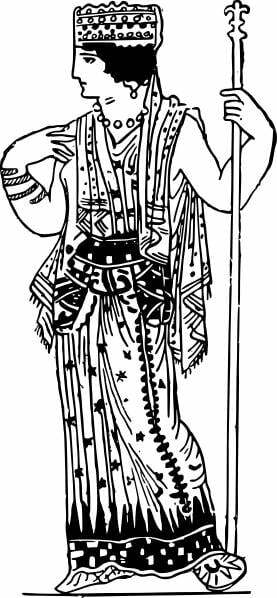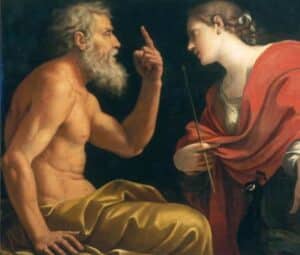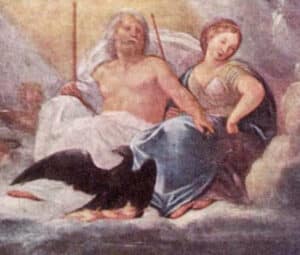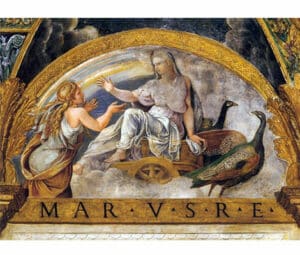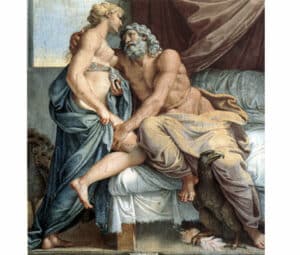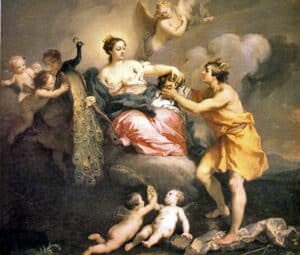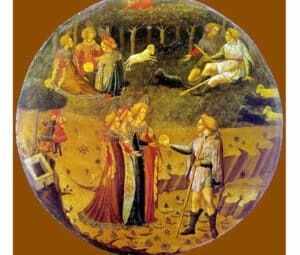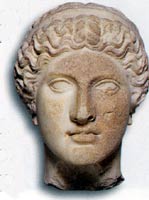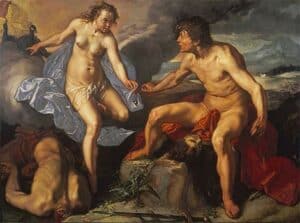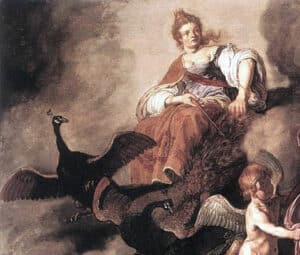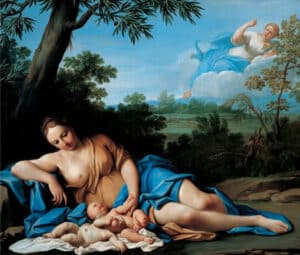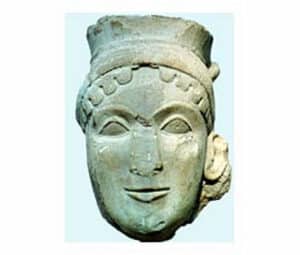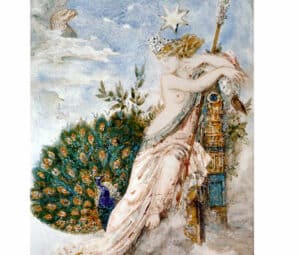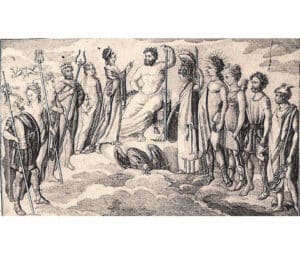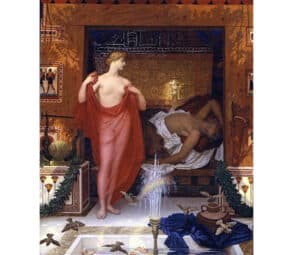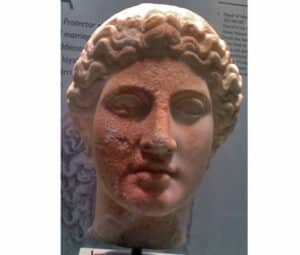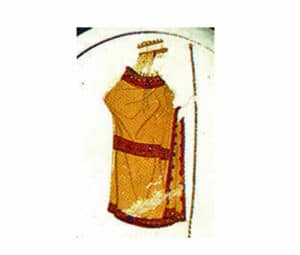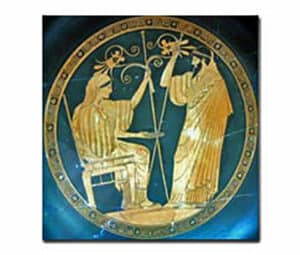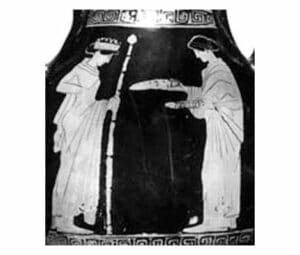Hera is the queen of the Olympian gods and the Greek goddess of marriage, family, and protector of women. She is portrayed as a strong matronly woman crowned with a diadem or as a married woman veiled. She is a fierce and vengeful goddess. Her symbols are the pomegranate, the scepter, and the crown.
Key Facts
Family tree
| Parents | Cronus and Rhea |
| Partner(s) | Zeus |
| Siblings | Hestia, the virgin goddess of the hearth, Hades, the god of the underworld, Poseidon, Zeus, Demeter, and Chiron |
| Offspring | Angelos, Arge, Ares, the Charites (Graces), The epitome of charm and beauty, Eileithyia, Eleutheria, Enyo, Eris, Hebe, Hephaestus |
Personality
| Roman Name | Juno |
| Other Names | Uni |
| Ancient Greek | Ἥρα |
| The God of | Sky, heavens, marriage, women |
| Symbols | Pomegranate, scepter, crown |
Name and Etymology
There are numerous etymologies for the name Hera. One of them relates it to the Greek word ὥρα hōra, which means season. So, according to this interpretation, the name Hera means the appropriate time for marriage.
According to Plato’s etymology, it derives from the Greek word ἐρατή eratē, which means beloved, and refers to Zeus’s love marriage. Plutarch offered a different interpretation, claiming that the name is allegorical and an anagram of aēr (ἀήρ, “air”).
Linear B decipherer John Chadwick linked the name to the Greek word for hero, ἥρως, but this etymology isn’t clear enough to be accepted. Furthermore, R.S.P Beekes has proposed that the etymology of her name has a pre-Greek origin. This pre-Greek origin also associates her with a matriarchal figure.
The Romans associated her with Juno and the Etruscans with Uni. Her Norse equivalent is Frigg.
Hera’s Origins and Family
Hera was the daughter of the Titans Cronus and Rhea and one of the six world-ruling Olympian gods. With her family, and future husband, she is central in the Greek pantheon of gods. Her father, Cronus, was fated to be dethroned by one of his children. So, after their birth, he swallowed them all. Hera didn’t escape it and she was doomed to perish in her father’s belly.
The fate of Hera and her siblings changed when her mother, Rhea, tricked Cronus and gave him a stone to swallow instead of the newborn Zeus. When Zeus reached maturity, he made his father cοught up all his siblings. Consequently, he overthrew his father, and the war between the Titans and the Olympians began.
The Titanomachy war lasted ten years and included numerous series of battles. Two generations of gods battled for control of the universe. Finally, the Olympians triumphed and seized control of Mount Olympus. Zeus married his sister, Hera, who became the queen of all gods and humans.
According to Hesiod’s Theogony, this is the origin story of the queen of all gods. Other sources claimed that Hera was born in Samos under a sacred Lygos tree. The tree was near the site of her holy temple, Heraion. In addition, she married Zeus near the Imbrasos River.
Hera and Zeus
Hera was the goddess of marriage and childbirth, and as such, she was maybe the only Olympian who did not have extramarital affairs. Even though Zeus was a cocky God who just wanted to father as many heroes as possible, the goddess remained faithful to him.
She was very charmed by Zeus, so she seduced him with her divine beauty. In other versions of the story, such as those told by Pausanias, Zeus seduced Hera by transforming himself into a cuckoo. Hera captured the bird and kept it, which is why a cuckoo sits on her scepter.
Another story has Zeus causing a terrible storm while Hera was on her way to Mount Thorax. He changed into a cuckoo and appeared to her, sitting on her lap. The goddess draped her cloak over him. Zeus later reverted to his human form, and he refused to let her go. She refused to have sexual relations with him, but Zeus promised to marry her if she did.
According to Callimachus, Zeus, and Hera’s wedding lasted three thousand years. He also mentioned in the texts that Gaia gave them the apples of Hesperides as a gift.
Hera was dissatisfied with her marriage because Zeus cheated on her and impregnated other women, both mortal and immortal. She never broke off the marriage and she remained faithful to him, no matter how awful he was behaving.
Hera’s Offspring
Hera had many children with Zeus. She was the mother of two of the Olympians, Ares, and Hephaestus. Hephaestus, the god of metallurgy, was rejected from the Heavens by Hera because he had a congenital impairment. He was raised by Thetis, a sea nymph and the Oceanide Eurynome, and when he became of age, he returned to take revenge on his mother.
Hera was also the mother of Ares, the god of war. She was also the mother of Enyo, the goddess of war, and Eris, the goddess of discord. Enyo and Eris were Ares’ companions on the battlefield. However, she was also the mother of Eleutheria, the personification of freedom.
The goddess of grace and beauty, namely the Charites – Aglaia, Euphrosyne, and Thalia – and the goddess of youth, Hebe, were also daughters of the Mother Goddess. As the goddess of marriage, she was also the mother of Eileithyia, the goddess of childbirth. Some lesser-known stories give us information on three more children: Angelos, an underworld deity, Arge, a nymph, and Typhon, a monstrous serpentine giant. Typhon, according to the Homeric Hymn to Apollo, was born out of the goddess with parthenogenesis, out of revenge for Zeus who had Athena by himself.
Depiction and Characteristics
Hera’s Appearance
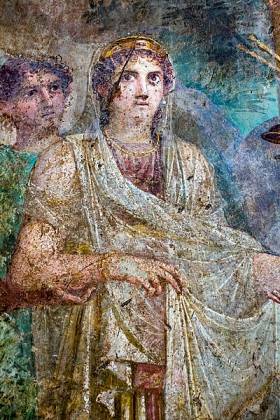
Hera, according to Greek mythology, is stunningly beautiful, even more so than Aphrodite. Her stature appeared to be tall and graceful. She also had beautiful, captivating eyes and white skin.
She used to dress up in veils and elegant clothes, like a bride-to-be. Hera also wore a high, cylindrical, golden crown studded with precious diamonds and a myriad of jewelry from head to toe – she also had pierced ears. The goddess held a royal scepter with a lotus on the top, and she was accompanied by a lion, a hawk, and a cuckoo.
Hera was very proud of her beauty and was very particular about her appearance because she wanted to be the most desirable goddess.
Hera’s Personality
Ancient writers described Hera as vengeful and ruthless. She was described as a wrathful and short-tempered goddess (like almost any other God, to be honest), who was set to exact revenge on her unfaithful husband’s lovers and his children.
As an example, Hera sent her daughter Eileithyia to prevent Alcmene from giving birth to Heracles, The Strongest Hero, and the Graeae, One-eyed Guards of the Gorgons to harden her labor. Heracles was born, but the goddess did not stop making his life difficult.
However, we must note that the narrative of the “jealous” Hera, who wreaks havoc on gods and humans with her vengeful nature, does not do her justice. Hera does not go around murdering or exacting vengeance on people out of sheer cruelty. And out of the hundreds of lovers and children that Zeus has, she only exacted revenge on a few of them.
Unable to exact her revenge on Zeus
The thing is, Zeus is more powerful than any other deity. Many gods have gone against mortals when they were unable to defeat some other god. Like Athena, the goddess of wisdom, who punished Medusa for Poseidon’s actions, or Apollo, who killed the Cyclops after Asclepius, the god of medicine‘ death even though Zeus was to blame, the goddess exacted revenge on mortals, in the hope that Zeus would care enough to behave.
However, Zeus was so full of himself that he didn’t care about anything, not even reprimanding Hera (or any other God) for interfering with the lives of those who were affected by him. So, without justifying the actions of the other gods or Hera, the root of the problem is Zeus and his abuse of his omnipotence and dominance over the rest of the Olympic Pantheon.
Finally, Hera took her role as a woman protector very seriously and was always available to assist women in need, particularly during pregnancy or labor. She also stood up for women whose husbands had abused them. When she wanted, she could be very caring, sweet, and compassionate.
Hera’s Powers
Hera was one of the six first-born gods and queen of all gods and humans, so she was a mighty goddess. Like all Olympians, she possessed superhuman strength, senses, and endurance. She could use her hands to kill giants, sense everything even from a great distance away, and stay awake for days on end.
Hera also possessed a multitude of other abilities. She possessed biokinesis, which gave her control over gods, humans, animals, and all living creatures, as well as a woman’s menstrual cycle. She could use telekinesis to move any object with her hand alone.
In addition, using pathokinesis, she could manipulate the minds of other people or demigods. She also had the power to change her appearance and transform herself as she pleased. Furthermore, she was able to curse anyone who was disrespectful to her, bless someone who deserved it or even turn people into monsters.
Finally, she could use atmokinesis to manipulate the weather, and aerokinesis to manipulate the wind. Even though Poseidon had power over earthquakes, she also had the power of terrakinesis, so she could control the earth and cause earthquakes.
Hera’s Sacred Symbols
Hera’s sacred symbols as the queen of all gods were her royal scepter and throne. Another symbol was the diadem, which was the ornamental crown she wore.
Hera’s Sacred Animals and Plants
The cuckoo was one of Hera’s sacred animals, and it represented Zeus’ love for her as he transformed into a cuckoo to worm his way into her chamber. Another was the peacock, which represents immortality and beauty.
Her other sacred animals included the lion, which represented her power, strength, and immortality, and the cow, which symbolized her role as a mother and woman as it is a nurturing animal.
Hera’s sacred plants included lotus flowers, willow trees, water lilies, and pomegranates. The pomegranate, in particular, symbolized fertility, which was essential to the goddess because she was the protector of women, particularly during childbirth.
Hera’s Roles and Responsibilities
Hera’s duties as queen were numerous. The most important of these was that she was the goddess of marriage and the protector of women. As a result, she had to protect marriages and women throughout their lives, particularly during labor. She had to be a role model for all women as a loyal wife, and she had to stay pure and trusting. The goddess would, however, protect women from men, especially if they were victims of abuse.
She was also a protector in general, as she used to protect entire cities such as Sparta, Mycenae, Argos, and Samos. She was also thought to be the patron of Argos and Samos.
Myths About Hera
The myths surrounding Hera’s marriage to Zeus and the birth of Hephaestus are well-known. Let’s review some other important myths.
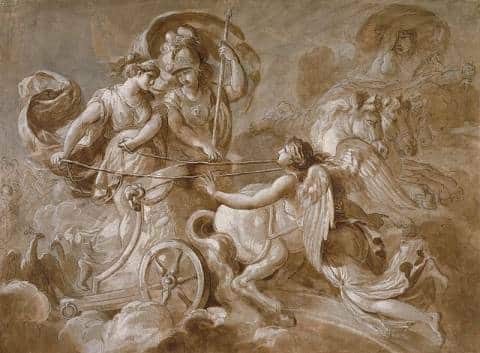
Judgement of Paris and Trojan War
At the wedding of Peleus and Thetis, the uninvited Eris made Paris choose the fairest among Hera, Athena, and Aphrodite by giving them a golden apple. Paris chose Aphrodite as his wife, and she promised him Helen, The Most Beautiful Woman In The World. In short, this resulted in the Trojan War.
During the Trojan War, Hera not only stood in for the Greeks, but she also swayed Zeus to assist them. Zeus made a deal with Thetis to aid the Trojans and avenge her son, Achilles, The Mightiest Champion of The Trojan War. This plan, however, did not sit well with the goddess. She seduced and put Zeus to sleep so that Poseidon could rally the Greek forces and aid them in their victory.
Hera and the peacock
In the heart of Mount Olympus, Hera, the Queen of the Gods, had a faithful watchman named Argus. Now, Argus wasn’t your ordinary guardian; he was gifted (or perhaps cursed) with a hundred eyes, making him the perfect sentinel. Indeed, with so many eyes, it was nearly impossible for anything to escape his vigilant gaze. Hera, ever the cunning goddess, often employed Argus’s services, especially when she wanted to keep an eye (or a hundred) on her often-wayward husband, Zeus.
One day, in a twist of fate and jealousy, Hera set Argus to watch over a maiden named Io, whom Zeus had taken a particular liking to. To protect Io from Hera’s wrath, Zeus transformed her into a beautiful white heifer. But Hera was no fool; she recognized the heifer and set Argus to guard her, ensuring Zeus couldn’t communicate with his beloved. However, as the days turned into nights, Zeus grew restless.
He sent Hermes, God of All Trades, to lull Argus into sleep and rescue Io. Using his charm and wit, Hermes played a soft tune that eventually made all of Argus’s eyes drift shut. Seizing the opportunity, Hermes swiftly ended Argus’s life. Hera, in her grief and to honor her fallen watchman, took Argus’s eyes and adorned the tail of the peacock, creating a living testament to his unwavering vigilance. And so, every time we gaze upon the mesmerizing feathers of a peacock, we’re reminded of Argus’s dedication and Hera’s deep-seated emotions.
Heracles
One of the victims of Hera’s wrath was Heracles, Alcmene’s and Zeus’ son. Hera despised the hero from the moment he was born and had been plotting his death ever since. Initially, she sent her daughter, Eilithyia, the goddess of childbirth, to prevent Heracles and his mortal twin brother from being born. After this plan failed, she sent two snakes to kill the baby in his cradle. Heracles’ superhuman strength, on the other hand, enabled him to strangle the two serpents to death.
Heracles grew up and moved to Thebes, where he married Princess Megara and raised a family. According to some authors, Hera drives Hercules insane, causing him to murder his children and possibly even his wife. Following the oracle, Heracles goes to serve Eurystheus and perform the twelve labors to atone for his sins, during which Hera, of course, makes his life miserable.
After making amends for murdering his children, Heracles joined the Argonauts (who were protected by Hera) in their quest for the Golden Fleece. During this adventure, Heracles met princess Iole, daughter of Eurytus, and had to compete in archery to win her. Eurytus, on the other hand, did not want his daughter to marry Heracles because he was well aware of what had happened to the demi-god’s first wife and children. Only Iphitus, one of Eurytus’ children, sided with Hercules.
Not only that, but during this whole thing, Eurytus cattle went missing. The culprit was Autolycus, the infamous thief and trickster of antiquity, the son of Hermes and grandfather of Odysseus, The Cunning Hero Of The Trojan War and Jason. Eurytus blamed Hercules and Autolycus, of course, did not contest that. Despite the fact that Iphitus was the only one who sided with Hercules and became his friend, Hera reappears, blinding Heracles with madness and making him murder Eurytus and all of his children, including Iphitus. He must serve Queen Omphale for three years to atone for that sin.
Needless to say, Hera made Hercules’ life difficult from the beginning to the end.
Pelias and Jason
As previously stated, Hera was a fierce protector of women. After Pelias, the king of Iolcos, committed the heinous act of murdering his maternal step-grandmother at Hera’s altar, she loathed him and vowed vengeance. Her flawless plan included Iason (Jason), the son of Aeson and legitimate king of Iolcos, and Medea, The Enchantress, a powerful sorceress.
Pelias was prophesied to lose his kingdom to the man with one sandal. And now was the time for Hera’s vengeance. When Jason became 20 years old, nursed by the centaur Cheiron, he set out to Iolcos to reclaim the throne from Pelias. Hera appeared before him as an elderly woman, and Jason, being a compassionate young man, assisted her in crossing the Anauros River, but he lost a sandal in the process. The goddess was aware of the young man’s quest, and her plan was taking shape in front of her eyes.
Pelias, fearful that the prophecy would come true, dispatched Jason to Colchis to retrieve the Golden Fleece, an impossible task. Jason set out for the quest with one of the strongest ships ever built, Argo, and a powerful team of heroes and demi-gods. Of course, they could never have reached Colchis without the assistance of the mighty goddess, who led them via the Clashing Rocks (Symplegades).
When they arrived at Colchis, The Enchanted Land of the Golden Fleece, Hera sent Eros, the Greek God of love to make Jason fall in love with the powerful enchantress Medea, the raven-haired priestess of Hecate, the goddess of magic. Medea assisted Jason in obtaining the golden fleece, and they set sail for Iolcos, with Hera always by their side, guiding them through trials such as Scylla, The Sea Monster of Ancient Lore and Charybdis, The Whirlpool Monster.
Medea’s deceit had Pelias killed when she arrived at Iolcos. Hera’s plan had been successful; she had avenged herself through Jason, The Leader Of The Argonauts. Pelias, who had desecrated her altar with murder, particularly a woman’s murder, was finally dead.
The wrath of Hera
As we have pointed out, Hera was a wrathful goddess. Her wrath had fallen upon:
- Callisto; she was turned into a bear to escape Hera and Artemis killed the girl with an arrow
- ·Io; the goddess punished the poor girl after Zeus slept with her by turning her into a cow, tie her on an olive tree, and have Argos Panoptes guard her
- Leto; the goddesshad sent Python, The Ancient Serpent, a dracon, to relentlessly pursue Leto when she was pregnant with Apollo and Artemis from Zeus.
- Semele; the goddess persuaded Semele to have Zeus appear before her in his divine form, something that would kill her – he did, Semele perished out of fright, and Zeus managed to save their son, Dionysus, the god of wine and revelry
Hera’s Place In Ancient Greek Religion
Sites Sacred to Hera
Around 800 BC, the ancient Greeks may have built the first roofed temple sanctuary to honor Hera on Samos. This temple was later replaced by another sanctuary, the Heraion, which was one of the most important temples. This demonstrates that Hera was more than just a minor Greek goddess of the Aegean.
The Greeks also dedicated Olympia’s first temple and two of Paestum’s most prestigious fifth and sixth-century Doric temples (550BC and 450 BC). Hera was also honored with temples in Corinth, Tiryns, Perachora, and Delos.
On the Greek mainland, a sanctuary was built between the former Mycenaean cities of Mycenae and Argos, which hosted the Heraia festivals in her honor. Hera’s sacred temples could also be found in her favorite cities, Argos, Mycenae, and Sparta.
Worship & Festivals
The Daedala festival was one of Hera’s festivals. This festival, which was held every four years in Plataea, Boeotia, was about reconciliation. Pausanias distinguished between the lesser and greater Deadala. The lesser was held every four years, while the greater was held every fourteen years.
People in the lesser Deadala went to an ancient oak grove and fed cooked meat to ravens. They were keeping an eye on which tree the ravens would fly to after stealing the meat. They carved an image of a bride out of this tree. A cheering crowd would accompany this image as it was drawn to the river Asopus and back to Plataea.
The people of Boeotia chose one of the figures that had accumulated over the previous years and designated her as the “bride” in the greater Daedala. They properly prepared the “bride” and raised her on a wagon. This wagon was taken to Mount Cithaeron, where people offered a heifer to Hera and a bull to Zeus, along with copious amounts of wine.
The Heraea was another festival. It is unknown when the festival began or how frequently it occurred. The stadion was the only event at this festival. Only unmarried young women could compete in three different categories in this race. The winners received an olive leaf wreath and a portion of cow’s meat dedicated to Hera. On March 7, there was also the Junolia, a Roman festival honoring Hera (Juno). This festival would end with a three-day feast.
play Hera’s Games
Test your knowledge about Hera with these two fun games!
You can also play around with Hera’s and other Olympian gods’ names in this fun anagram game:
Do you want more? Here you can play our other games.
Representations In Art
Hera is depicted on a throne alongside Zeus in ancient Greek art. In the Parthenon frieze in Athens, for example, she turns toward Zeus while holding her veil open. She is depicted in various paintings with Zeus as an allegory of marriage in postclassical art. Rubens’ Medici cycle, Henri at Lyons, and The Meeting of Marie are examples of such works.
The artists concentrated on depicting her rage at Zeus in other paintings. In Ingres’ painting of Jupiter and Thetis, for example, she appears threateningly on the left side of the composition. Hera is also depicted in the paintings The Judgement of Paris, El Juicio de Paris, The Origin of the Milky Way, and The Birth of the Milky Way. There were few depictions of Hera in art in the early nineteenth century.
In The Old Texts
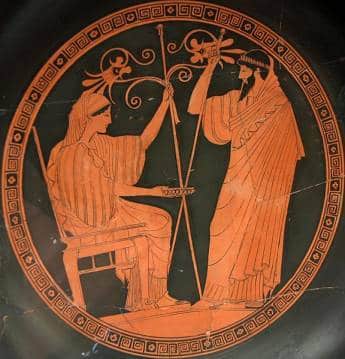
Hera was mentioned frequently in the works of ancient Greek and Latin writers, as she played an important role in their stories. In the Iliad and Odyssey, Homer referred to Hera as one of the Olympians who was an ally of the Greeks. Hera is also mentioned in Homeric hymns and religious poems from the seventh and sixth centuries.
Furthermore, Hesiod wrote about Hera, specifically her origins, in his texts Theogony and the Works and Days. Her relationships with various heroes are mentioned in Pindar’s surviving poems. He wrote about how she helped Jason and the Argonauts and how she tried to kill Heracles, for example.
In Aeschylus’ tragedy Prometheus Bound, he tells the story of Prometheus, The Titan Who Defied Zeus stealing fire from heaven and receiving Zeus’ punishment. He meets Io during his sentence, who explains Hera’s pursuit of her.
In his philosophical epic On the Nature of Things, Lucretius mentioned that the cult of the Olympian gods was misguided in Latin old texts. Hera is an important character in Virgil’s epic poem, The Aeneid. In this text, Aeneas, the Trojan hero arrives in Italy following the Trojan War, and the goddess appears to be his adversary. Valerius Flaccus referred to Hera as the Argonauts’ patron in his epic Argonautica. Finally, Silius Italicus mentioned in the Punica that the goddess was the main divine enemy of the Romans in Hannibal’s war, as well as Hannibal’s ally.
FAQs
Hera was the goddess of marriage and protector of women during labor.
Hera’s parents were Cronus and Rhea.
She had three brothers and sisters: Hestia, Hades, Poseidon, Zeus, Demeter, and Chiron, The Wise Centaur.
She had eleven children, Angelos, Arge, Ares, the Charites, Eileithyia, Eleutheria, Enyo, Eris, Hebe, and Hephaestus.
Zeus
The Norse goddess Frigg, wife to Odin.
Sources
Aeschylus
- Prometheus Bound
Hesiod
- Theogony 453, 921, 927
Homer
- Homeric Hymn to Apollo
- Homeric Hymn to Hera
- Iliad 1.397, 14.200
- Odyssey 11.601
Ovid
- Metamorphoses 2.512
- Heroides 4
Pseudo-Apollodorus
- Bibliotheca 1
Valerius Flaccus
- Argonautica 2.82
Featured Image Credit: Berlin Painter, Public domain, via Wikimedia Commons

